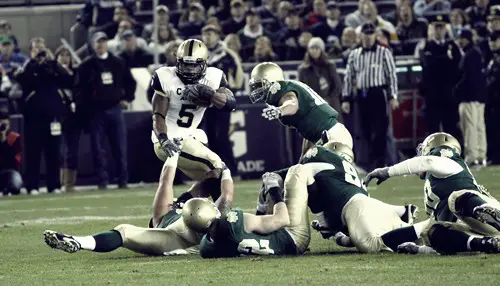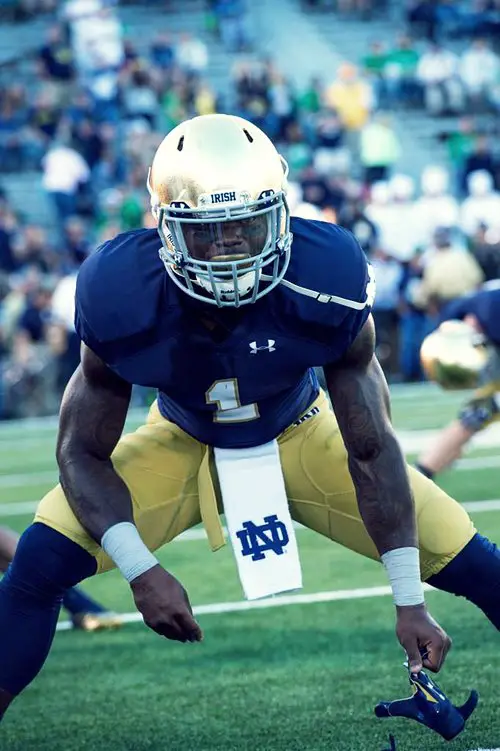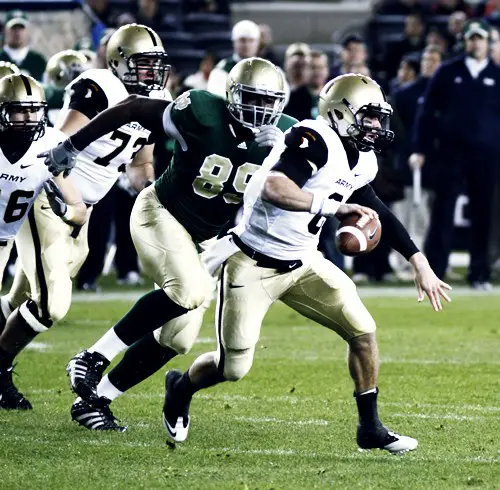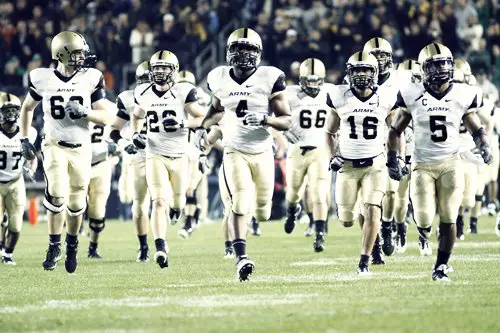
Presentation:
Notre Dame football is inseparable from custom, greatness, and an energetic fan base. As one of the most celebrated school football programs ever, the Battling Irish have made a permanent imprint on the game. While many are know all about the group’s notorious minutes, there are a few less popular realities about Notre Dame football that merit acknowledgment.
The Beginnings of the Battling Irish Moniker:
In opposition to mainstream thinking, the “Battling Irish” moniker didn’t begin from the group’s relentlessness on the field. It was really begat by rival groups in the mid twentieth hundred years as an overly critical term, yet Notre Dame gladly embraced it, transforming it into an image of strength and assurance.
The Primary Heisman Prize Victor:
In 1937, Notre Dame’s halfback, Angelo Bertelli, turned into the main Battling Irish player to win the Heisman Prize. Bertelli’s striking passing abilities and initiative capacities cemented Notre Dame’s standing as a stalwart program.
The Four Horsemen’s Record:

While the Four Horsemen are respected as perhaps of the best backfield in school football history, many are ignorant that they never lost a game during their three years playing together. Their undefeated streak from 1922 to 1924 remaining parts an unrivaled accomplishment.
Notre Dame’s Unpredictable Arena:
Notre Dame Arena is known for its closeness to the field, giving a one of a kind and cozy game-day experience. Dissimilar to customary arenas, the Battling Irish’s home turf doesn’t have a common passage entrance for the players, building up the group’s solidarity as they enter through the stands.
The Shift to the Forward Pass:

In the mid twentieth hundred years, Notre Dame changed the sport of football by accentuating the utilization of the forward pass. Under the direction of incredible mentor Knute Rockne, the Battling Irish displayed the capability of this essential play, perpetually changing the game’s elements.
The Best Group of the 1940s:
Notre Dame football arose as the best group of the 1940s, laying out a tradition of predominance and greatness that set its place as quite possibly of the best program in school football history. Driven by unbelievable lead trainer Honest Leahy, the Battling Irish made unrivaled progress during 10 years, catching numerous public titles and making a permanent imprint on the game.
The 1940s were a time of wonderful accomplishment for Notre Dame football, as the group amassed a noteworthy record and guaranteed four public titles. Under the direction of Mentor Leahy, the Battling Irish displayed a blend of ability, discipline, and vital brightness that pushed them to the zenith of the school football scene.
The ten years started with a bang, as Notre Dame went undefeated in the 1940 season, getting a public title and hardening their status as a football force to be reckoned with. The group’s prosperity went on in the ensuing years, as they caught two additional public titles in 1943 and 1946. The Battling Irish showed outstanding ability and flexibility, succeeding on both offense and safeguard, and reliably beating their rivals.
One of the central traits of Notre Dame football during the 1940s was its capacity to create extraordinary individual ability. The group flaunted a program loaded up with extraordinary players who made critical commitments to their prosperity. Players like Angelo Bertelli, Johnny Lujack, and Leon Hart became commonly recognized names, procuring Every single American honor and making a permanent imprint on the program’s celebrated history.
Mentor Leahy’s creative training strategies and scrupulousness were instrumental in Notre Dame’s prosperity during this period. He carried out a thorough preparation program, underlining discipline and collaboration, and imparting a triumphant mindset inside the group. Leahy’s essential discernment and capacity to adjust to various adversaries permitted the Battling Irish to outsmart their opponents on the field reliably.
Past their great win-misfortune record, Notre Dame’s predominance during the 1940s lastingly affected the program and school football in general. The group’s prosperity raised the college’s standing, drawing in top-level ability and laying out Notre Dame as an objective for hopeful football players. The Battling Irish became inseparable from greatness, and their accomplishments during the 1940s set up for future victories and set their status as a school football force to be reckoned with.
All in all, Notre Dame football’s unrivaled outcome during the 1940s solidified its place as the best group of the 10 years. Driven by the visionary instructing of Honest Leahy and energized by outstanding ability and discipline, the Battling Irish caught four public titles and set a norm of greatness that keeps on characterizing the program. The group’s accomplishments not just left an enduring effect on Notre Dame football yet in addition molded the scene of school football all in all. The tradition of the most dominating group of the 1940s fills in as a demonstration of the getting through significance of Notre Dame football.
The Remarkable “Round of the 100 years”:

The remarkable “Round of the 100 years” in Notre Dame football history occurred on November 19, 1993, while the Battling Irish went head to head against the Florida State Seminoles. The matchup between the No. 2 Notre Dame and the No. 1 Florida State was exceptionally expected, with the two groups flaunting great records and public title desires. The game satisfied its monstrous promotion and turned into a moment exemplary, enthralling fans and establishing its place in school football legend.
The conflict between Notre Dame and Florida State was something beyond a football match-up; it was a skirmish of two forces to be reckoned with, each drove by unbelievable mentors in Lou Holtz and Bobby Bowden. The game had colossal ramifications, as the victor would probably get a spot in the public title game. The stage was set for a legendary confrontation, and the groups didn’t dishearten.
From the initial opening shot, it was clear that the game would be a firmly challenged fight. The two offenses displayed their instability, exchanging scores all through the game. The guards were similarly impressive, conveying bone-pounding hits and making vital stops. The environment was electric, with fans from the two sides as eager and anxious as can be, seeing history unfurl.
With a little more than a moment staying in the game, Notre Dame ended up following 31-24. Quarterback Rick Mirer drove an exceptional drive down the field, covered off by a score pass to Adrian Jarrell with simply 1:39 left at work. As opposed to choosing the tie, Mentor Holtz went with the intense choice to go for a two-point change and the success. Mirer dropped back to pass, however the Seminoles’ safeguard amassed him, constraining an inadequate pass and fixing the triumph for Florida State.
The game was a close to home exciting ride, loaded up with exciting plays, grasp exhibitions, and heart-halting minutes. It exhibited the versatility and assurance of the two groups, as they left everything on the field in quest for triumph. The “Round of the Hundred years” satisfied its charging and made a permanent imprint on school football history.
Past the actual game, the meaning of the matchup reached out a long ways past the last score. It featured the serious rivalry and the quest for greatness that characterizes school football. The game exhibited the ability and expertise of the players, the essential splendor of the mentors, and the energy and commitment of the fans. It turned into an image of the game’s capacity to dazzle and join individuals from varying backgrounds.
All in all, the “Round of the 100 years” between Notre Dame and Florida State in 1993 stands as one of the most extraordinary crossroads in Notre Dame football history. The conflict between two stalwart projects, the high stakes, and the undeniably exhilarating nature of the game made it a moment exemplary. The matchup displayed the best of school football, leaving a getting through heritage and helping us to remember the game’s capacity to make enduring recollections and unite individuals.
The Longshot Triumphs:
Notre Dame football has a rich history of longshot triumphs that have caught the hearts of fans and set the program’s standing for flexibility and assurance. Over time, the Battling Irish have challenged the chances and won against impressive adversaries, displaying their capacity to adapt to the situation and accomplish significance notwithstanding affliction.
One of the most notorious longshot triumphs in Notre Dame football history came in the 1978 season while the Battling Irish confronted the highest level and undefeated College of Southern California (USC) Trojans. Notre Dame, drove by lead trainer Dan Devine, entered the game as critical longshots. Nonetheless, the Battling Irish revitalized together and conveyed a dazzling execution, overcoming USC by a score of 27-25. The triumph not just finished the Trojans’ 23-game series of wins yet additionally got Notre Dame’s spot in the public title game.
One more significant longshot triumph happened in the 1993 season when Notre Dame confronted the then-leaned toward Florida State Seminoles, who were positioned No. 1 in the country. The Battling Irish, drove by lead trainer Lou Holtz, entered the game as huge dark horses. In any case, Notre Dame’s safeguard moved forward, capturing two passes in the last minutes to get an emotional 31-24 triumph. The success impelled the Battling Irish to an undefeated season and a public title.
As of late, Notre Dame has kept on creating longshot triumphs that stand out enough to be noticed. One such triumph came in the 2012 season while the Battling Irish confronted the Oklahoma Sooners, who were positioned No. 8 at that point. Regardless of being questioned by a larger number of people, Notre Dame’s safeguard conveyed a predominant execution, holding Oklahoma’s powerful offense scoreless in a 30-13 triumph. The success hardened Notre Dame’s re-visitation of public conspicuousness and pushed them to a spot in the BCS
Public Title Game.
These longshot triumphs embody Notre Dame football’s capacity to adapt to the situation and surprise everyone. They grandstand the program’s strength, assurance, and capacity to perform under tension. The Battling Irish have a well established custom of embracing the dark horse job and involving it as inspiration to accomplish significance.
Past the actual triumphs, these dark horse wins lastingly affect Notre Dame football and its fans. They act as tokens of the program’s celebrated history and its capacity to beat affliction. These triumphs likewise rouse current and future players, advising them that with difficult work, conviction, and a refusal to withdraw, the sky is the limit.
Taking everything into account, Notre Dame football’s dark horse triumphs have turned into a fundamental piece of the program’s set of experiences and inheritance. These victories against imposing adversaries exhibit the Battling Irish’s capacity to adapt to the situation and accomplish significance notwithstanding misfortune. The dark horse triumphs catch the hearts of fans as well as act as tokens of the program’s flexibility, assurance, and capacity to conquer the chances. Notre Dame football’s longshot triumphs move players, fans, and the more extensive school football local area, helping every one of us to remember the force of conviction and the potential for significance.
The Scholastic Greatness of Understudy Competitors:
Notre Dame football has for quite some time been famous for its athletic accomplishments as well as for its obligation to scholarly greatness. The program invests heavily in the comprehensive improvement of its understudy competitors, underlining the significance of training and encouraging a culture of scholastic achievement. Notre Dame’s devotion to keeping up with high scholarly principles separates it and has laid out a custom of greatness both on and off the field.
Understudy competitors at Notre Dame are held to thorough scholarly guidelines, guaranteeing that they succeed in their athletic interests as well as in their examinations. The college puts serious areas of strength for an on the worth of instruction, and understudy competitors are urged to seek after their scholastic objectives with similar degree of devotion and responsibility they bring to their athletic undertakings. Notre Dame’s understudy competitors are supposed to satisfy similar scholarly prerequisites as their non-competitor peers, keeping a harmony between their athletic responsibilities and their coursework.
To help the scholastic progress of its understudy competitors, Notre Dame gives a scope of assets and emotionally supportive networks. The college offers scholarly exhorting, mentoring administrations, concentrate on lobbies, and devoted scholastic staff who work intimately with understudy competitors to guarantee they have the fundamental instruments and support to scholastically flourish. Moreover, Notre Dame puts areas of strength for an on time usage abilities, assisting understudy competitors with exploring their requesting timetables and equilibrium their intellectual and athletic obligations successfully.
The obligation to scholastic greatness at Notre Dame is reflected in the noteworthy scholarly accomplishments of its understudy competitors. Numerous players have been perceived for their insightful achievements, getting scholastic distinctions, grants, and grants. The football program reliably flaunts high graduation rates and has areas of strength for a record of creating effective alumni who succeed in different fields past football.
Notre Dame’s devotion to scholarly greatness reaches out past individual accomplishments. The program underlines the significance of collaboration and a steady climate for scholarly achievement. Understudy competitors are urged to help each other scholastically, encouraging a local area that values learning and scholarly development. The program’s obligation to scholastic accomplishment has made a culture where understudy competitors take a stab at greatness in all parts of their lives.
The scholastic progress of Notre Dame’s understudy competitors is a wellspring of pride for the college and the football program. It represents the guiding principle of the establishment and exhibits the conviction that schooling and sports can remain closely connected. Notre Dame football remains as a demonstration of the possibility that understudy competitors can succeed both on the field and in the homeroom, and that athletic achievement and scholarly accomplishment are not fundamentally unrelated.
All in all, Notre Dame football’s obligation to scholastic greatness separates it as a program that esteems the all encompassing improvement of its understudy competitors. By stressing the significance of training and offering the essential help and assets, Notre Dame cultivates a culture of scholarly achievement. The program’s noteworthy scholastic accomplishments, high graduation rates, and the acknowledgment got by its understudy competitors show the program’s commitment to offsetting athletic pursuits with insightful undertakings. Notre Dame football remains as a brilliant illustration of how scholastic greatness and athletic achievement can coincide, moving understudy competitors to take a stab at significance both on and off the field.
The Notre Dame-Naval force Series:
The Notre Dame-Naval force series is a noteworthy and valued competition in school football that traces all the way back to 1927. The yearly matchup between the Notre Dame Battling Irish and the Naval force Sailors has become perhaps of the most loved custom in the two projects, representing the crossing point of football and military help. The series holds an exceptional importance and epitomizes the honorable upsides, regard, and sportsmanship.
The Notre Dame-Naval force series started because of Notre Dame’s eagerness to plan Naval force during when numerous other football programs were reluctant to do as such. This choice was driven by the shared regard and esteem between the two establishments, as both hold major areas of strength for a to the improvement of understudy competitors and their devotion to serving their country.
Over time, the Notre Dame-Naval force series has delivered various important minutes and firmly challenged games. The matchups have frequently been described by an elevated degree of contest and sportsmanship, as the two groups carry their best to the field. The games have included astounding individual exhibitions and emotional completes the process of, dazzling fans from the two sides.
The series has likewise assumed a huge part in encouraging kinship and figuring out between the two scholastically famous foundations. The Notre Dame-Naval force game is something beyond a football match-up; it is a chance for the understudy competitors, graduated class, and fans to meet up and praise the common qualities and customs of their individual foundations. The game fills in as a sign of the connection between the military and the more extensive society, and the significance of respecting the people who serve.
The Notre Dame-Naval force series has additionally been set apart by snapshots of sportsmanship and regard. Every year, the groups trade gifts before the game, representing the common adoration and regard between the foundations. The players from the two groups frequently structure enduring companionships and associations, perceiving the common encounters and obligation to greatness on and off the field.
Past the football field, the Notre Dame-Naval force series broaderly affects the school football scene. The series has displayed the special crossing point of sports and military help, moving different projects to plan games against administration foundations and featuring the respectable upsides, discipline, and collaboration that are integral to the two establishments.
All in all, the Notre Dame-Naval force series is a valued and memorable contention in school football. The yearly matchup between the Battling Irish and the Sailors addresses the crossing point of football and military help, epitomizing the praiseworthy upsides, regard, and sportsmanship. The series has delivered critical minutes, firmly challenged games, and enduring associations between the two foundations. Past the football field, the Notre Dame-Naval force series fills in as a sign of the connection between the military and society, rousing others and featuring the qualities that the two foundations hold dear.
End:
Notre Dame football’s rich history stretches out a long ways past the celebrated triumphs and famous figures. These less popular realities shed light on the program’s determination, creative commitments, and obligation to scholastic greatness. As fans keep on embracing the Battling Irish’s celebrated heritage, these unexpected, yet invaluable treasures add profundity and importance to the persevering through soul of Notre Dame football.

